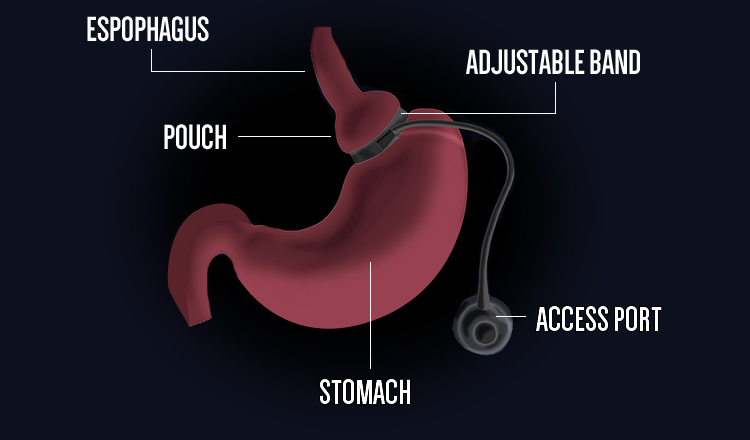
Consumers all over the country have been promised answers to their weight problems through a variety of diets, drugs, and surgeries that promise to boost their self-esteem and their health. However, relying on an invasive surgery like the Lap-Band to meet health goals over maintaining good habits through diet and exercise inevitably has its risks and possible complications. The Lap-Band system is described as a seemingly simple way for extremely overweight people to lose weight fast. This occurs after an invasive surgery, where an adjustable band is placed around the stomach of the patient, reducing it’s size and causing the patient to eat far less than normal. However, the lap band procedure (aka Laparoscopic Gastric Banding) has many issues. Aside from just costs of the procedure (the average cost for a Lap band surgery is anywhere from $17,000-$30,000) there are many serious side effects. Lap band lawsuits are becoming more and more common as the amount of people seriously harmed continues to rise.
In one study, research found there was a 26% chance of developing complications after having a Lap Band surgery done. While death is not likely to occur – 3 fatalities to every 1,000 procedures – It is still a possibility both during and after the surgery.
Laparoscopic Gastric Banding surgery falls under the category of “bariatric surgery”, which is only 1 of the 4 types of weight loss.
The four types of weight loss surgery procedures available are:
- Laparoscopic gastric banding (Lap-Band)
- Vertical sleeve gastrectomy
- Gastric bypass surgery
- Band-over-bypass surgery
The Lap Band Surgery
During the Lap Band procedure, an adjustable silicon band containing a reservoir gets placed around the upper part of the stomach. The doctor will cut several small incisions and place a camera, and other surgical tools through these to allow the device to be wrapped around – forming a ring. Patients need to have a Body Mass Index (BMI) of at least 40kg/m2 or greater, or a BMI of 35 or greater with at least 2 comorbidities before undergoing the surgery. In most cases, this would be 80 lbs. overweight for women and 100 lbs. overweight for men.
A thin tube will be attached to the ring and left under the skin, providing an access port for the doctor to make adjustments to the band. A small needle containing a type of saline solution is distributed through the port – by increasing or decreasing the amount of saline added, the band could either be tightened or loosened. By having a tighter band, this process changes the stomach’s size, which helps you feel full sooner and eat less.
While in surgery, the band will not be inflated. For the band to be adjusted, you will need to be fully recovered from your surgery, taking anywhere from 4-8 weeks. The surgery itself takes around one hour in the operating room, and one night of recovery in the hospital. In some cases, hospital stays may last longer.
Post Surgery Complications, Side Effects and Risks
Research has showed that almost half of all patients who have had the gastric banding surgery experienced some type of malfunction or erosion, which caused them to have the band removed. Although it may be the least invasive weight-loss surgery – compared to the stapling and cutting of the stomach during a gastric bypass surgery – the Lap Band has showed to also be the least effective in actual weight loss.
While the band is inflated, it is actually squeezing the stomach together creating the patient’s desired diameter for the food opening. While some inflammation and swelling in the stomach is normal to occur after a band insertion. There is also risk if too much swelling were to occur, a blockage would be formed causing food unable to pass through the stomach.
Between 15-40% of patients experienced the most common problem of the Lap Band surgery, known as band slippage. This happens over time by the ring slipping down the stomach, causing another surgery to repair and restore the normal band positioning.
Other reported side effects of the Lap Band have included:
- Implant migration (band erosion, band slippage, band intolerance, band leak)
- Port problems (port flip, port infection, port dislocation, port leak)
- Stomach obstruction
- Esophageal dilation
- Gastroesophageal reflux disease (GERD)
- Blood clots
- Gallstones
- Nausea and vomiting
- Bowel function changes
- Difficulty swallowing
- Poor nutrition
- Dehydration
- Internal bleeding
- Pouch dilation
- Infection
- Extreme Dehydration
- Constipation
- Constant and severe nausea
- Erosion of Lap-Band into the stomach
- Ulceration
- Tear in the stomach wall
- Indigestion
- Blood Cots
- Death
Lap Band Studies
In 2011 – a study was developed which followed 82 patients who had undergone the Lap band surgery between 1994-1997. Of those patients, 40% had experienced serious complications, 22% had minor complications, and 60% needed some type of subsequent surgery. If you are experiencing complications after having a Lap Band surgery, you may want to speak to a lawyer to find out your legal rights and options. Hundreds of lawsuit cases against clinics that perform Lap-Band surgery have been presented all over the country after patients being misled or uninformed of the serious risk involved. The Los Angeles Times reported that 5 people have died due to Lap-Band related complications since 2009 in just Southern California alone.
Lap-Band and the FDA
You can read more about lap band surgery over on the FDA website here.
Celebrities who have had the Lap Band surgery
- Sharon Osbourne – Had her lap band removed after experiencing complications
- Lauren Manzo – Real Housewives of New Jersey
- Chris Christie – Governor State of New Jersey
- Rex Ryan – New York Jets Coach
- Corey Harrison from Pawn Stars
- Khaliah Ali




37 Comments